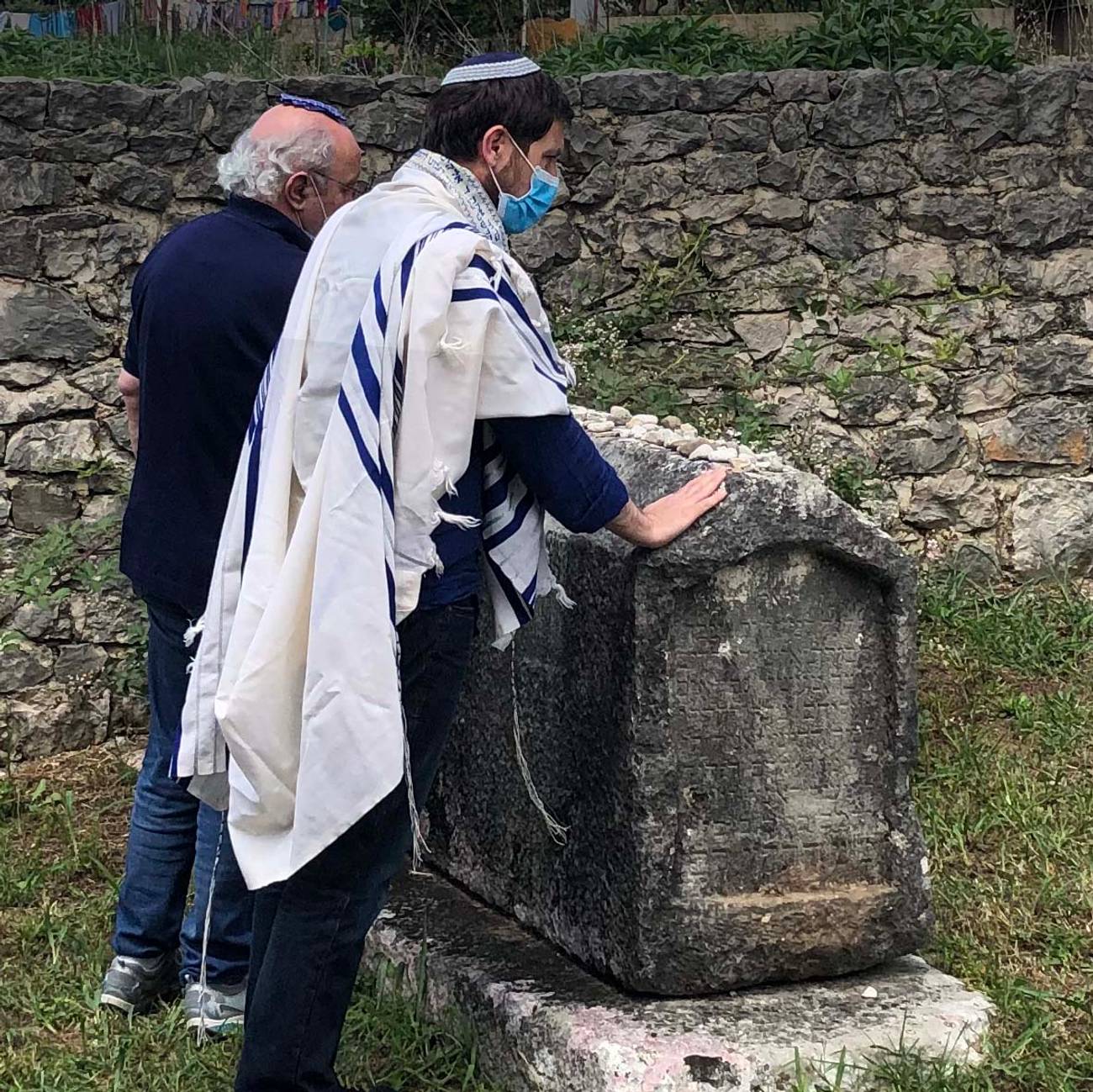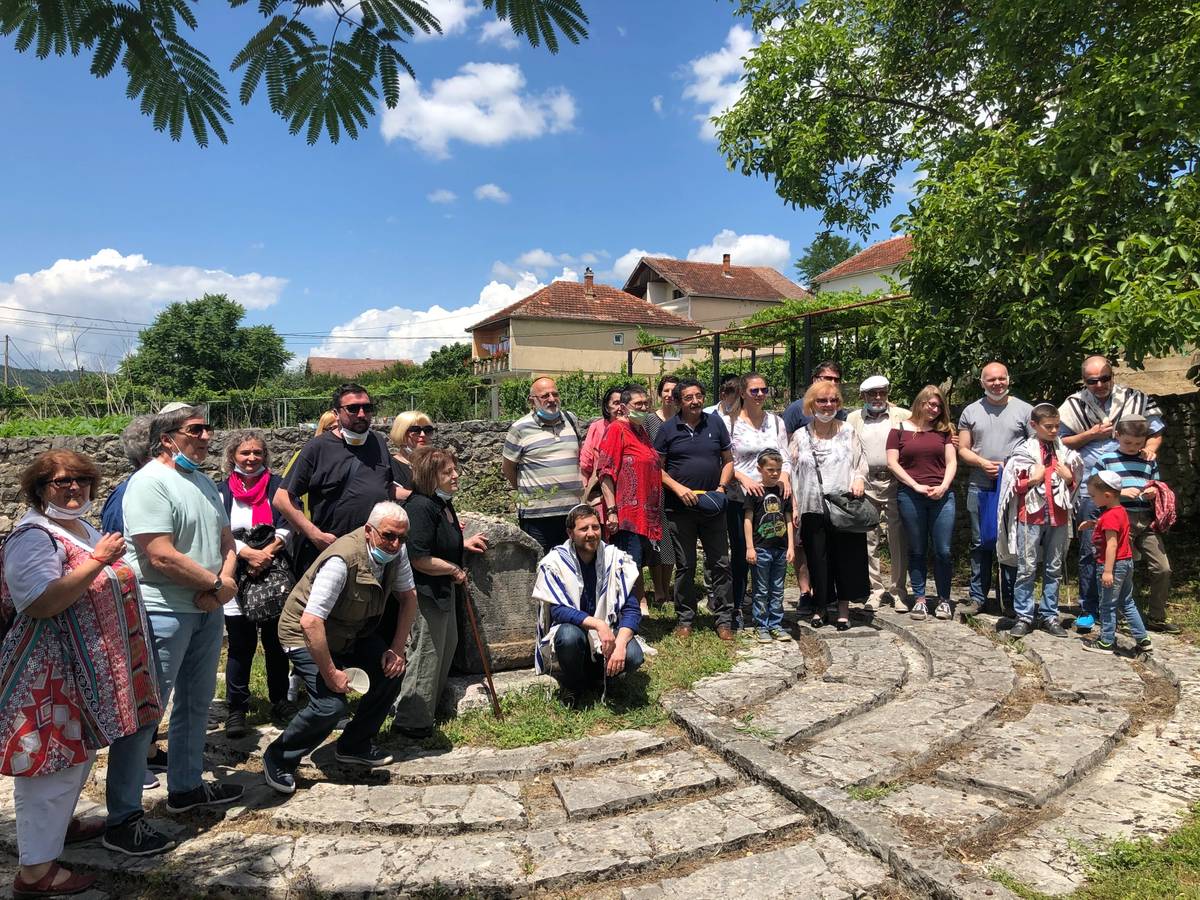A Welcome Excursion for Bosnian Jews
After months in quarantine during the pandemic, Sarajevo’s community once again gathers for an annual pilgrimage




While synagogues in America are still mulling whether or not they will be open in time for the High Holidays, nearly 40 members of Sarajevo’s Jewish community recently traveled together to the grave of Rabbi Moshe Danon in southern Bosnia-Herzegovina.
The June 14 trip was the first major get-together for the small community since the country ended its state of emergency due to the COVID-19 pandemic and eased social distancing restrictions at the end of May. The quarantine period was especially difficult for Sarajevo’s Jews, who largely fall in the most vulnerable demographic of those over the age of 65. Under Bosnia’s social distancing measures those over 65 and under 18 were not allowed to leave their homes at all for months.
During this extended quarantine, the loss of a communal Passover Seder was a major blow for the city. Not just because it is famed for its Haggadah but because during the Yugoslav period, Passover became the most prominent Jewish holiday observed by Yugoslavia’s Jewish communities.
“Pesach is extra special here,” explained Igor Kozemjakin, who serves as cantor at Sarajevo’s sole active synagogue, “During the socialist times it was the only holiday that was publicly observed. We used to invite the leaders of the Communist Party to the Seder. It was a religious holiday, but it was easy to connect to the universal values of freedom, fighting against oppression, and the other narratives that were held up by the Marxists.”
Passover ultimately eclipsed Yom Kippur as the most prominent Jewish holiday during the Yugoslav period, and that mentality has remained among Sarajevan Jews. Some 200 community members logged on for an online Seder run by Kozemjakin, this year, but he acknowledged it wasn’t the same.
Therefore, at least for Kozemjakin, the opportunity to be together once more at Danon’s grave was a small victory over the virus. “For me it was pretty amazing, especially the number,” he said. “No one in the community expected so many people to show up.”
The trip wasn’t without precautions, however: Community members were instructed to come with masks and an extra-large bus was ordered, so those who wanted could maintain some measure of social distance on the three-hour journey.
“This is a really strong tradition in our community, which people are going to try as hard as they can to fulfill,” Kozemjakin explained. “I don’t know how many people here really believe in miracles, probably not most, but still they are worried about a second wave and to pray at the grave of the tzadik, to keep up our traditions, it helps them.”
Moshe Danon is perhaps the most famous rabbinic figure out of Bosnia-Herzegovina. A kabbalist who served the community of Sarajevo as Haham Bashi (Chief Rabbi) in the early 19th century, he was also a key character in the Megillah of the Purim de Saray, the Sarajevo Jewish community’s own local story of peril and redemption.
As the story goes, in 1820, after a murder of a local Dervish, Rudzi-Pasha, the corrupt Ottoman governor of Sarajevo, kidnapped 11 prominent Jews including Rabbi Danon. The Pasha accused them of the murder of the Dervish who was a convert to Islam, and held them for ransom, demanding 50,000 groschen of silver from the Jewish community.
However, in Sarajevo, where the Jewish, Muslim, and Chrisitan communities had long lived in relative harmony, the Jews had allies and the kidnapping of Danon instigated a local uprising against Rudzi-Pasha, supported by the Muslim community as well. Alongside the Jews, thousands of Muslims stormed the castle, demanding the release of Danon and the other Jewish notables from its dungeons, as well as the overthrow of the Pasha.

The anniversary of the event is celebrated every year in November by the city’s Jewish community, often with a trip to Sarajevo’s Jewish cemetery and the grave of the famous Sarajevan Jewish historian Moshe ben Rafael Attias, better known by his pen name Zeki Effendi, who documented the story of the Purim de Saray and wrote a biography of Danon.
“For Sarajevo, Rabbi Moshe Danon is a very important person,” Kozemjakin explained. “Not only among the Jews, but Muslims as well—after all, the Jews didn’t rebel alone. He gained their respect as a god-fearing man.”
Danon, however, isn’t buried in the city where he spent most of his days. At the end of his life, dreaming of making aliyah before his end, Danon began traveling south, making his way toward the Holy Land. He didn’t make it far though, Danon passed away in Herzegovina, the southern portion of Bosnia-Herzegovina, and was buried just outside the city of Stolac, near the modern border with Croatia, about 100 miles south of Sarajevo
His grave has been a pilgrimage site for Bosnia’s Jews ever since, a tradition established by Zeki Effendi, and every year, around the time of his yahrzeit, the 20th of Sivan, which generally falls between mid-June and early July on the Gregorian calendar, the Jewish community of Sarajevo organizes a group trip to the grave. That tradition was maintained under Ottoman, Austro-Hungarian, and Yugoslav rule, having only been interrupted during the Holocaust and the Bosnian war of 1992-95.
Of course, the novel coronavirus put that plan into doubt this year.
“It was a question of whether we could go or not,” explained Vladimir Andrle, who is a member of the Jewish community’s crisis response team. “The biggest issue of, course, was our concern for the community’s health, but after our discussions and the easing of emergency measures in Bosnia and Herzegovina, as well as the fact that over the entire period of quarantine we did not have a single instance of infection within the Jewish community, led us to decide to go.”
Andrle however, said he had little doubt that he would be at the grave of Danon this year.
“For me it was out of the question, if the community is going, I would be going,” said Andrle. “This trip to the grave of Moshe Danon, is one of the most important traditions of the Bosnian Jewish community, it is part of both our Jewish heritage and our Bosnian heritage as the story of Rabbi Danon is a symbol of the interreligious respect that has existed here for centuries.”
The pilgrimage to Danon’s grave was also an opportunity for the community to tour the nearby scenic town of Stolac, where they visited the home of Mehmedalija “Mak” Dizdar, a beloved Bosnian poet, and ate in Jablanica, a scenic town known for its roast lamb and WWII partisan history, as the site of the Battle of the Neretva river between Nazi forces and Tito’s partisans in 1943.
It was a welcome excursion for a community that has spent months cooped up in Sarajevo.
David Klein is a New York-based journalist who found himself sheltering in place in Sarajevo as the world descended into pandemic.